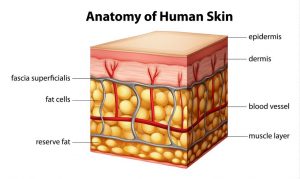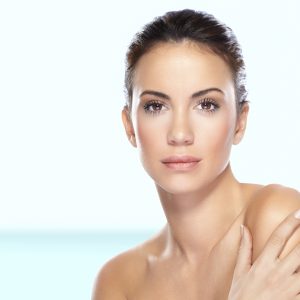How NOT to Look Old
Understanding and Treating Your Skin better, One Layer at a Time
 As a skin care professional, we make every effort to look at the skin critically and assess details about what is happening on several levels.
As a skin care professional, we make every effort to look at the skin critically and assess details about what is happening on several levels.
The different layers are:
- Epidermis – the outer layer, the one we see, and the outer most epidermal layer is called the stratum corneum
- Basal layer – the thin layer that separates the epidermis and the dermis. It is this layer that we find the melanocytes that give us our tan color by producing the pigment melanin.
- Dermis – the deepest and thickest layer. This is where we find fibrocytes that create collagen and elastin as well as the adipocytes that produce the subcutaneous fatty layer. In between the cells is the substance called glycosomineglycans (GAG) that fills in the space and acts like a scaffold holding it all together. The collagen provides volume and strength and the elastin gives our skin elasticity. The deterioration of any of these elements advances the appearance of aging.
What happens to my skin when it ages?
 One of the most visible signs of premature aging is a thinning of both epidermis and dermis. This occurs when free radicals attack our skin during excess sun exposure. Free radicals damage all layers of the skin. The fibroblast cease to produce enough collagen and elastin and the GAG deteriorates. The skin dries without sufficient production of moisture, pigmentation becomes abnormal because of melanocyte damage, and we lose blood supply to the skin.
One of the most visible signs of premature aging is a thinning of both epidermis and dermis. This occurs when free radicals attack our skin during excess sun exposure. Free radicals damage all layers of the skin. The fibroblast cease to produce enough collagen and elastin and the GAG deteriorates. The skin dries without sufficient production of moisture, pigmentation becomes abnormal because of melanocyte damage, and we lose blood supply to the skin.
With less blood supply, the nutrients cannot get to the various cells, and the waste products are not eliminated sufficiently. Ultimately, mutations can occur and from then we get an increase in the incidence of cancer.
What can we do about it?
You’ve heard it before, but bears reminding:
- Don’t get too much sun,
- Don’t smoke cigarettes
- Don’t use harsh chemicals on the skin.
- Eat a healthful diet with a variety of vegetables. Limit the simple carbohydrates that produce AGEs (advanced glycation end products). A bad diet full of simple carbohydrates results in glycation , or molecular by-products, that “gum up” the works. This byproduct attaches to elastin, enzymes, immunoglobulins and causes sagging and ineffective metabolism. The result: it puts aging into overdrive..
Do use a good skin care program and sun block to protect yourself!
A good skincare program can offer the following:
– Moisturization – without occlusive oiliness
– Nutrients – some of which should be from whole foods, such as marine algae
– Vitamin A analog — such as retinol or retinyl palmitate, which increases collagen and elastin production and increases blood supply to the skin
– Anti-glycation ingredients – one of which is carnosine
– Anti-inflammatories – green tea is an example
– DNA repair – such as seen with Cat’s Claw (uncaria tomantosa)
– Resveratrol to help turn on youth genes
– Peptides – two of which are the most commonly seen are Matrixyl Synthe 6 (the latest of the Matrixyls) and Argireline. The former signals the fibroblasts to increase collagen production while decreasing collagen breakdown, and the latter relaxes the muscles just below the skin to reduce wrinkles. The effects of both of these peptides take a month or so to see the benefits.
With the New Youth System of Cosmeceuticals, we combine all of these necessary ingredients and delivery systems into a 7-product system or regimen, which is our basic starter kit. It’s a holistic approach to good skin, and we make it easy. Generally the pubic, and the patients I see everyday, don’t know which nutrients your skin needs. An example would be a person that wants to reduce pigmentation spots, so they would use the Fade Serum. This would help some, but the improvement would be many times better and faster with using the New Youth Basic Kit because the products are synergistic with each other. In addition, their skin would look much younger, tighter and with fewer wrinkles than simply reducing age spots.





